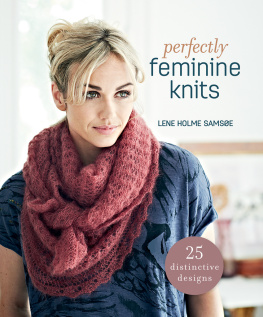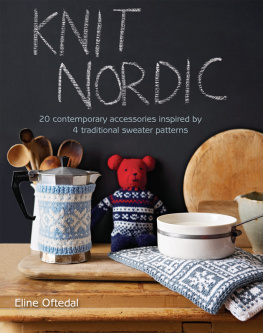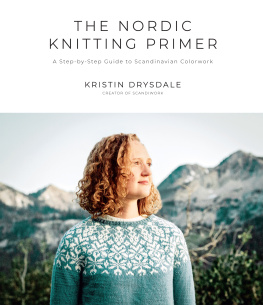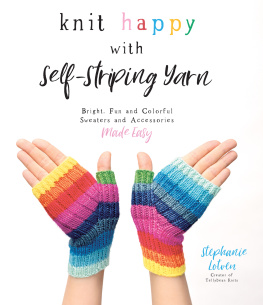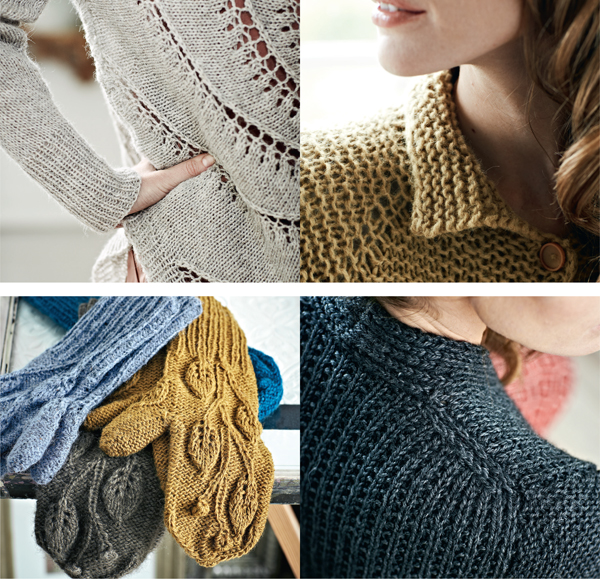Contents
Guide
25 distinctive designs
Lene Holme Samse
CONTENTS
Introduction: Survival of the Knittest
The great interest in handknitting, which was considered just a curious retro fad and a passing fashion a few years ago, continues at a steady pace. Knitting is meditative, but it can also be done as a social activity, and now entire online communities have built up around itso not only is it fun to knit, its good for the soul. In turn, knitters represent todays spirit because their craft fits perfectly with the current trend of experimenting and exploring to create something original for yourself and others. Knitting is very adaptable to the times. No wonder it has endured as a popular hobby.
You can become addicted to knitting. It isnt surprising that many knitting enthusiasts affectionately describe their local yarn stores as yarn pushers. With yarn and needles in your hands, breathing deepens, and you can achieve a sense of quiet that purifies your thoughtsalmost like yoga, but more restful!
When you knit it yourself, you can produce something thats just as attractive as a ready-made knit garment from the shops. However, for handknits, you can choose pure new wool or another natural fiber instead of the synthetics that factory-produced knitwear is unfortunately frequently made from, and which is often more expensive.
This collection includes cardigans, sweaters, ponchos, mittens, a cap, a cowl, scarves, and a shawl. Designs range from easy to more complicated models, so theres something for everyone.
I hope this book will inspire you to create new projects with knitting needles and lovely yarn in your hands.
Lene Holme Samse
How to Use This Book
Sizes
Most of the garments in this book are worked in sizes small, medium, large, or extra-large. The measurements given below show the body measurements that each size covers.
When deciding on what size to knit, its a good idea to compare the measurements of the item you want to knit with your own measurements. The measurement schematics give you a good overview of the garments shape. You can compare the measurements on the schematic with one of your items of clothing to decide if the fit is something you want. If a top, for example, is quite fitted with the given measurements but you prefer something looser, you can choose a larger size for a wider and roomier garment.
All the garments shown in the book were knitted in size small and are shown on models who wear size small (36).
Adjustments
If your measurements differ quite a bit from those on the schematic, you can still change the pattern, in much the same way you would adjust the cutting lines on a sewing pattern.
The clothing here was designed for a person about 5 feet 412 inches to 5 feet 712 inches (164172 cm) tall. If youre taller or shorter, it might, for example, be necessary to make the sleeves longer or shorter than specified. The same applies if you have arms that are longer or shorter than average for your height. If youre much taller or shorter than average, it might also be necessary to knit the body longer or shorter as measured at the side seams. If the garment has a defined waistline, make sure that the waist hits at the right spot on your body.
Materials
I always use natural fiber yarns, primarily wool, but also kid mohair, cashmere, alpaca, and silk. At the end of the book youll find a description of each of the yarns I used. If you want to substitute yarns, try to match the original yarns yards/ounces (or meters/grams), fiber content, and the recommended gauge. Its a good idea to buy extra yarn if youre not using the one suggested in the pattern.
Instructions
Do yourself a favor: Read all the way through the instructions before you begin knitting.
Some techniques and information apply to every pattern and are not repeated in each set of instructions. These are explained below.
Gauge
The gauge indicates how many stitches there should be in a 4-inch (10 cm) width and the number of rows (if applicable) for every 4 inches (10 cm) of length.
Before you start knitting a pattern, you must be certain that your gauge matches that specified in the instructions. Always knit a gauge swatch! Knit it with the same size needles and in the same pattern as specified in the gauge information (for example, stockinette). Make it a little larger than 4 4 inches (10 10 cm). For example, CO 30 sts and work until the swatch is about 512 inches (14 cm) long. BO loosely. Block the swatch as you plan to block the pieces.
Lay the swatch flat on a table and mark off 4 inches (10 cm) across with a pin on each side. If you also need to check the row gauge, mark it off in the same way. Now count the number of stitches across the width between the pins and the number of rows between the pins for the length. If you have precisely the same number of stitches and rows as indicated in the instructions, then youre good to go! If you have more stitches across than indicated in the pattern, you have knitted too tightly and should try again with needles one U.S. (one-half metric) size biggerand vice versa. If you have fewer stitches across than specified in the pattern, then you should try needles one U.S. (one-half metric) size smaller. If your gauge varies too much from the pattern gauge, then you should try needles two or more U.S. (one or more metric) sizes smaller or larger. If your gauge varies only by a very small amount from the given gauge, then you might try using slightly smaller needles for working WS rows or, alternatively, slightly larger needles for RS rows. This advice applies only to stockinette because many knitters work the knit rows more tightly than the purl rows.
It pays to take some time with the gauge swatch because small differences in gauge can result in a big difference in the finished size of the garment. If you have 19 stitches in 4 inches (10 cm) instead of 20 as indicated in the pattern, your sweater could end up a size larger than you planned!

